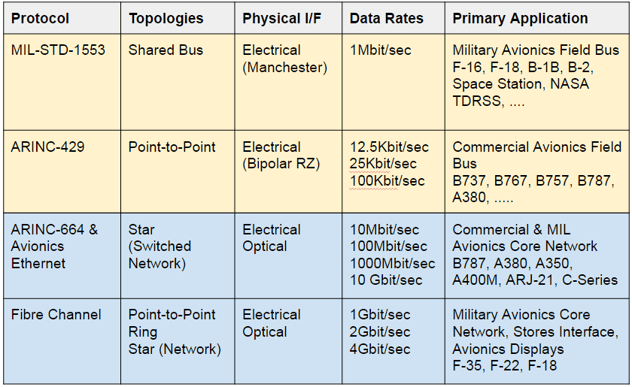As avionics system have increased in complexity, so has the the demand for supporting networks that are capable of handling ever increasing amounts of data bandwidth. The table below provides a summary of some of the common avionics data bus and network technologies currently employed in aircraft systems.

As traditional bus technologies like MIL-STD-1553, ARINC 429, and ARINC 629 give way to avionics network technologies like Fibre Channel and Ethernet huge increases in the volume of avionics system traffic are being realized. As a result of the shift away from shared bus architectures towards switched networks based on Ethernet and Fibre Channel, the test and simulation systems and tools used to test and integrate avionics systems have also had to adapt.
With a shared bus, test equipment can easily attached to the avionics system components via a single physical connection to the bus. This fact, coupled with the slower speeds associated with the legacy shared bus technologies means that test systems, in the past, have required fewer instruments than the newest systems used for networks avionics systems test. With networked avionics systems such as Fibre Channel and Ethernet there is typically a switch at the core of the network. These switches can commonly provide 24 or more physical ports therefore to test a high number of network interfaces are required of the test system. Also, to verify the integrated networks, since all traffic can not be accessed via a connection to a shared bus, high numbers of physical connections are required to tap the network segments between the core switch and the end systems.
This all means that test systems supporting these types of avionics networks must be capable of accomodating large numbers of network interfaces and therefor large numbers of test instruments. With larger numbers of instruments, a key challenge becomes synchronization of the instruments and finding host test systems to house and control the instruments. A natural choice for these test systems is the use of PXI Express because of the availability of high slot count chassis and because PXI Express provides standardized instrumentation signals which can be used for timing and syncrhonization of instruments.
For detailed information about PXI Express, Testing Ethernet Switches and testing Fibre Channel switches check out these AIT instructional videos:
Testing Ethernet Switches
Testing Fibre Channel Switches
PXI Express Overview


